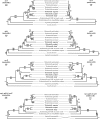Discovery of novel Rickettsiella spp. in ixodid ticks from Western Canada
- PMID: 24334664
- PMCID: PMC3911054
- DOI: 10.1128/AEM.03564-13
Discovery of novel Rickettsiella spp. in ixodid ticks from Western Canada
Abstract
The genomic DNA from four species of ixodid ticks in western Canada was tested for the presence of Rickettsiella by PCR analyses targeting the 16S rRNA gene. Eighty-eight percent of the Ixodes angustus (n = 270), 43% of the I. sculptus (n = 61), and 4% of the I. kingi (n = 93) individuals examined were PCR positive for Rickettsiella, whereas there was no evidence for the presence of Rickettsiella in Dermacentor andersoni (n = 45). Three different single-strand conformation polymorphism profiles of the 16S rRNA gene were detected among amplicons derived from Rickettsiella-positive ticks, each corresponding to a different sequence type. Furthermore, each sequence type was associated with a different tick species. Phylogenetic analyses of sequence data of the 16S rRNA gene and three other genes (rpsA, gidA, and sucB) revealed that all three sequence types were placed in a clade that contained species and pathotypes of the genus Rickettsiella. The bacterium in I. kingi represented the sister taxon to the Rickettsiella in I. sculptus, and both formed a clade with Rickettsiella grylli from crickets (Gryllus bimaculatus) and "R. ixodidis" from I. woodi. In contrast, the Rickettsiella in I. angustus was not a member of this clade but was placed external to the clade comprising the pathotypes of R. popilliae. The results indicate the existence of at least two new species of Rickettsiella: one in I. angustus and another in I. kingi and I. sculptus. However, the Rickettsiella strains in I. kingi and I. sculptus may also represent different species because each had unique sequences for all four genes.
Figures



Similar articles
-
A novel Rickettsia species detected in Vole Ticks (Ixodes angustus) from Western Canada.Appl Environ Microbiol. 2013 Dec;79(24):7583-9. doi: 10.1128/AEM.02286-13. Epub 2013 Sep 27. Appl Environ Microbiol. 2013. PMID: 24077705 Free PMC article.
-
Multilocus sequence typing (MLST) for the infra-generic taxonomic classification of entomopathogenic Rickettsiella bacteria.FEMS Microbiol Lett. 2011 Nov;324(2):125-34. doi: 10.1111/j.1574-6968.2011.02396.x. Epub 2011 Sep 20. FEMS Microbiol Lett. 2011. PMID: 22092813
-
Genetic and electron-microscopic characterization of 'Rickettsiella agriotidis', a new Rickettsiella pathotype associated with wireworm, Agriotes sp. (Coleoptera: Elateridae).Curr Microbiol. 2011 Aug;63(2):158-63. doi: 10.1007/s00284-011-9958-5. Epub 2011 Jun 3. Curr Microbiol. 2011. PMID: 21638041
-
A Rickettsiella bacterium from the hard tick, Ixodes woodi: molecular taxonomy combining multilocus sequence typing (MLST) with significance testing.PLoS One. 2012;7(5):e38062. doi: 10.1371/journal.pone.0038062. Epub 2012 May 31. PLoS One. 2012. PMID: 22675436 Free PMC article.
-
Ticks and Tick-Borne Diseases of Colorado, Including New State Records for Argas radiatus (Ixodida: Argasidae) and Ixodes brunneus (Ixodida: Ixodidae).J Med Entomol. 2021 Mar 12;58(2):505-517. doi: 10.1093/jme/tjaa232. J Med Entomol. 2021. PMID: 33164093 Review.
Cited by
-
Impact of endosymbionts on tick physiology and fitness.Parasitology. 2023 Sep;150(10):859-865. doi: 10.1017/S0031182023000793. Epub 2023 Aug 24. Parasitology. 2023. PMID: 37722758 Free PMC article. Review.
-
The Tick Microbiome: Why Non-pathogenic Microorganisms Matter in Tick Biology and Pathogen Transmission.Front Cell Infect Microbiol. 2017 Jun 8;7:236. doi: 10.3389/fcimb.2017.00236. eCollection 2017. Front Cell Infect Microbiol. 2017. PMID: 28642842 Free PMC article. Review.
-
Diversity of bacteriome associated with Phlebotomus chinensis (Diptera: Psychodidae) sand flies in two wild populations from China.Sci Rep. 2016 Nov 7;6:36406. doi: 10.1038/srep36406. Sci Rep. 2016. PMID: 27819272 Free PMC article.
-
Differences in Gut Microbiome Composition Between Sympatric Wild and Allopatric Laboratory Populations of Omnivorous Cockroaches.Front Microbiol. 2021 Jul 28;12:703785. doi: 10.3389/fmicb.2021.703785. eCollection 2021. Front Microbiol. 2021. PMID: 34394050 Free PMC article.
-
The Genetic Diversity of Rickettsiella Symbionts in Ixodes ricinus Throughout Europe.Microb Ecol. 2022 Aug;84(2):613-626. doi: 10.1007/s00248-021-01869-7. Epub 2021 Sep 28. Microb Ecol. 2022. PMID: 34580739 Free PMC article.
References
-
- Hongoh Y, Deevong P, Inoue T, Moriya S, Trakulnaleamsai S, Ohkuma M, Vongkaluang C, Noparatnaraporn N, Kudo T. 2005. Intra- and interspecific comparisons of bacterial diversity and community structure support coevolution of gut microbiota and termite host. Appl. Environ. Microbiol. 71:6590–6599. 10.1128/AEM.71.11.6590-6599.2005 - DOI - PMC - PubMed
-
- Burgdorfer W, Hayes SF, Mavros AJ. 1981. Nonpathogenic rickettsiae in Dermacentor andersoni: a limiting factor for the distribution of Rickettsia rickettsii, p 585–594 In Burgdorfer W, Anacker RL. (ed), Rickettsiae and rickettsial diseases. Academic Press, Inc, New York, NY
Publication types
MeSH terms
Substances
Associated data
- Actions
- Actions
- Actions
- Actions
- Actions
- Actions
- Actions
- Actions
- Actions
LinkOut - more resources
Full Text Sources
Other Literature Sources
Molecular Biology Databases
Miscellaneous

